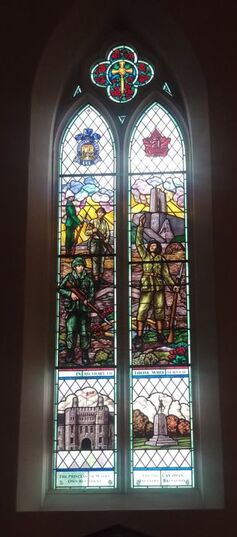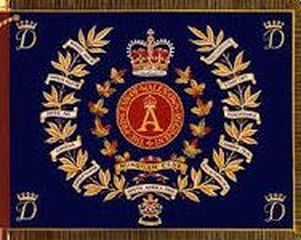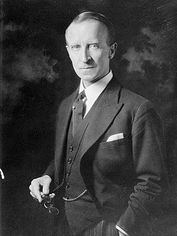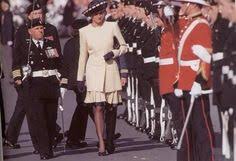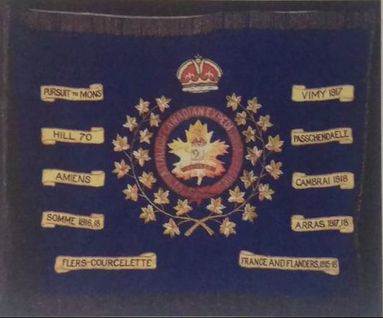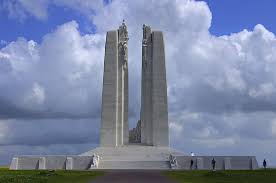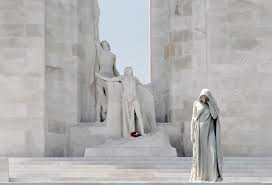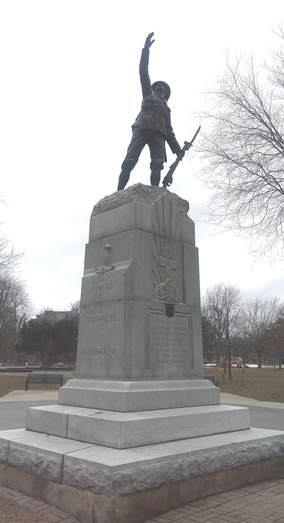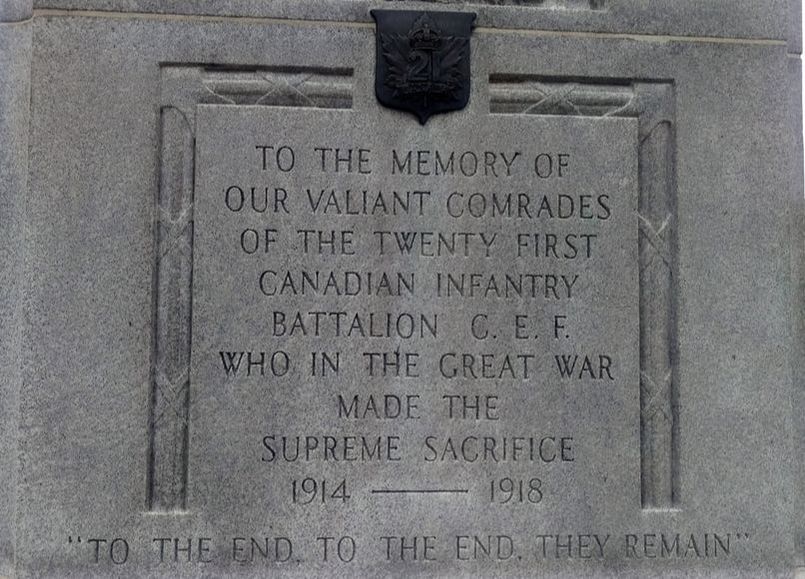Memorial Stained Glass Window at St. Paul's
The dedication of a memorial stained glass window at St. Paul's, commemorating those who served in the 21st Canadian Infantry Battalion, Canadian Expeditionary Force, and in the Princess of Wales' Own Regiment, took place on 13 May 2007. |
The Princess of Wales' Own Regiment
The Regiment was founded on 16 January 1863 as the 14th Battalion Volunteer Militia Rifles, Canada. On 03 July1868, it was renamed the 14th Battalion, Princess of Wales' Own Rifles (PWOR) in honour of Alexandra, Princess of Wales, whose marriage took place in 1863.
During the Fenian troubles, the 14th was called-out to Cornwall in 1866, and placed on active service in Kingston in 1870. During the Northwest Rebellion, the PWOR garrisoned Fort Henry from April 1885 to September 1886. Volunteers from the PWOR served in the South African War, 1899-1902, in sufficient numbers to earn the Battle Honour South Africa, 1900.
At the outbreak of the First World War in August 1914, the PWOR was called-out to guard vital points in Kingston until October 1917. Also it became a recruiting base for the Canadian Expeditionary Force (CEF). A company was sent to the 2nd Canadian Infantry Battalion, which proceeded overseas as part of the 1st Canadian Infantry Division in the fall of 1914.
On 03 November 1914, the PWOR raised the 21st Canadian Infantry Battalion, CEF, part of the 2nd Canadian Infantry Division, supplying officers and men, including its commanding officer, LCol W. St. Pierre Hughes. The Regiment also supplied the commanding officers and many officers and men to the 59th, 146th, and 253rd Canadian Infantry Battalions, CEF, all of which were raised in Kingston.
During the Fenian troubles, the 14th was called-out to Cornwall in 1866, and placed on active service in Kingston in 1870. During the Northwest Rebellion, the PWOR garrisoned Fort Henry from April 1885 to September 1886. Volunteers from the PWOR served in the South African War, 1899-1902, in sufficient numbers to earn the Battle Honour South Africa, 1900.
At the outbreak of the First World War in August 1914, the PWOR was called-out to guard vital points in Kingston until October 1917. Also it became a recruiting base for the Canadian Expeditionary Force (CEF). A company was sent to the 2nd Canadian Infantry Battalion, which proceeded overseas as part of the 1st Canadian Infantry Division in the fall of 1914.
On 03 November 1914, the PWOR raised the 21st Canadian Infantry Battalion, CEF, part of the 2nd Canadian Infantry Division, supplying officers and men, including its commanding officer, LCol W. St. Pierre Hughes. The Regiment also supplied the commanding officers and many officers and men to the 59th, 146th, and 253rd Canadian Infantry Battalions, CEF, all of which were raised in Kingston.
In 1920, the PWOR changed from a rifle battalion to a line regiment in order to have Colours displaying the Battle Honours of the 21st Battalion, which it perpetuated along with the 59th and 253rd Battalions. In 1936, the Regiment received its first set of Colours from the Governor General, The Rt Hon. Baron Tweedsmuir of Elsfield. In 1937, the unit was re-organized as a machine gun battalion. |
During the Second World War the PWOR contributed a company in 1940 to the Stormont, Dundas and Glengarry Highlanders, Canadian Active Service Force (CASF). Led by LCol G.H. Christiansen, ex-PWOR, the "Glens" went ashore on D-Day as part of the 9th Canadian Highland Brigade, commanded by BGen D.G. Cunningham, ex-PWOR. In June 1942, the Regiment formed a 1st Battalion for active service, but it was disbanded in Canada in October 1943. Most of its officers and men were sent to overseas units as reinforcements.
In 1946, the Regiment returned to its original role as an infantry battalion, part of the Canadian Army Militia. As such, it supplied officers and non-commissioned members to the Canadian Army Special Force during the Korean War, and to the Canadian Army Regular for many of its peace-keeping missions. In recent years, the PWOR has sent personnel to supplement the Regular Force in its peace-making operations in Afghanistan.
In 1963, the Regiment celebrated its centennial by receiving its second set of Colours, which included on the Regimental Colour, the Regimental Badge of Stormont, Dundas and Glengarry Highlanders with the years 1944-45. Also that year, it was granted the Freedom of the City of Kingston.
In 1946, the Regiment returned to its original role as an infantry battalion, part of the Canadian Army Militia. As such, it supplied officers and non-commissioned members to the Canadian Army Special Force during the Korean War, and to the Canadian Army Regular for many of its peace-keeping missions. In recent years, the PWOR has sent personnel to supplement the Regular Force in its peace-making operations in Afghanistan.
In 1963, the Regiment celebrated its centennial by receiving its second set of Colours, which included on the Regimental Colour, the Regimental Badge of Stormont, Dundas and Glengarry Highlanders with the years 1944-45. Also that year, it was granted the Freedom of the City of Kingston.
The Regiment is the 8th oldest in Canada, and continues to serve proudly and with distinction. As its record shows, the PWOR has earned the unofficial title of Kingston's Own.
The 21st Canadian Infantry Battalion (Eastern Ontario Regiment)
Canadian Expeditionary Force, 1914 - 1919
Just 11 days after the 1st Canadian Division sailed for overseas, the Hon. Sam Hughes, Minister of Militia and Defence, authorized the formation of a second division. On 19 October 1914, his youngest brother, LCol William St. Pierre Hughes, commanding the 14th Regiment, Princess of Wales' Own Rifles in Kingston, was ordered to raise the 21st Battalion to be part of the 4th Brigade. On 03 November 1914, the battalion was formed in Kingston from 15 eastern Ontario militia regiments, along with 93 men from the RCHA.
After training over the winter, the Battalion left for overseas on 05 May 1915. The unit of 42 officers and 1,142 men, led by its goat mascot Nan, was seen-off by a crowd of 14,000. The Battalion landed near Plymouth, England and proceeded to a training camp in Kent. There the 21st continued its training along with the other units of the 4th Brigade, which left for France on 15 September 1915. On 22 September 22 the Battalion entered the trenches in the Ypres Salient, staying there for the next six months in a relatively quiet front, learning to survive.
On 27 March 1916, six large mines were blown at St. Eloi as the British attempted to remove a small German salient. After a month of vicious fighting, the Germans still held it in spite of bloody attacks by the 1st and 2nd Canadian Divisions. In May, the Germans captured much of the Mount Sorrel salient. Regaining the ground cost the Canadian Corps 8,000 casualties. The 21st was heavily involved in both these operations, suffering 127 casualties at St. Eloi and 116 at Mount Sorrel.
On 01 July 1916, the British began the Somme offensive. Although the blood-bath continued until the end of November, the Canadian Corps, now consisting of four divisions, was not involved until 15 September, when the battle for Courcelette took place. The 21st played a significant role in its capture, but at a cost of over 400 casualties. The Battalion was moved to a more quiet sector for the remaining months of 1916, a year which cost it 211 killed.
After training over the winter, the Battalion left for overseas on 05 May 1915. The unit of 42 officers and 1,142 men, led by its goat mascot Nan, was seen-off by a crowd of 14,000. The Battalion landed near Plymouth, England and proceeded to a training camp in Kent. There the 21st continued its training along with the other units of the 4th Brigade, which left for France on 15 September 1915. On 22 September 22 the Battalion entered the trenches in the Ypres Salient, staying there for the next six months in a relatively quiet front, learning to survive.
On 27 March 1916, six large mines were blown at St. Eloi as the British attempted to remove a small German salient. After a month of vicious fighting, the Germans still held it in spite of bloody attacks by the 1st and 2nd Canadian Divisions. In May, the Germans captured much of the Mount Sorrel salient. Regaining the ground cost the Canadian Corps 8,000 casualties. The 21st was heavily involved in both these operations, suffering 127 casualties at St. Eloi and 116 at Mount Sorrel.
On 01 July 1916, the British began the Somme offensive. Although the blood-bath continued until the end of November, the Canadian Corps, now consisting of four divisions, was not involved until 15 September, when the battle for Courcelette took place. The 21st played a significant role in its capture, but at a cost of over 400 casualties. The Battalion was moved to a more quiet sector for the remaining months of 1916, a year which cost it 211 killed.
The early part of 1917 was spent by the Canadians preparing for the successful attack on Vimy Ridge on 09 April. The 21st suffered over 200 of the nearly 11,000 casualties.
|
Then in November, the Canadians were sent to capture Passchendaele. Once again, the 21st was involved in heavy fighting, with heavy losses. These three successful battles of 1917 cost the Battalion 394 killed.
The first part of 1918 saw the 21st in a relatively quiet sector. It was the calm before the storm as the Canadian Corps led the British attack at Amiens on 01 August, which led to the breaking of the German defences and the end of the war. The final 100 days of the war cost the Battalion most of its 260 killed in 1918. As part of the Army of Occupation, the 21st marched over the Rhine River at Bonn on 13 December. It was given the place of honour as it led the whole of the 2nd Division in the victory celebration.
In January, the Battalion was withdrawn to Belgium and then to England in April. Finally, on 13 May the Battalion left England. It arrived in Kingston on 24 May, and after a short ceremony on the Market Square, was disbanded. The Battalion was in existence for 4 years, 6 months, and 22 days, during which just over 5,000 officers and men served in its ranks. They earned 18 battle honours and over 300 personal decorations at a cost of over 800 killed and many more wounded.
Even before the war ended, a 21st Battalion Association was formed, which built the impressive monument in Kingston's City Park to its fallen.Lest We Forget
|
© 2024 St. Paul's Anglican Church Kingston
